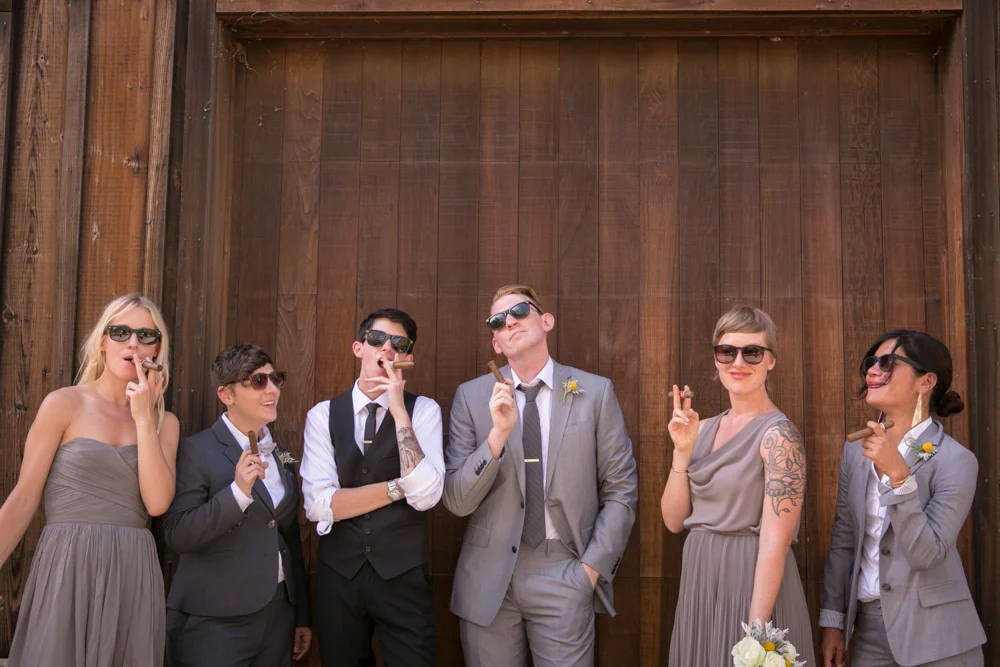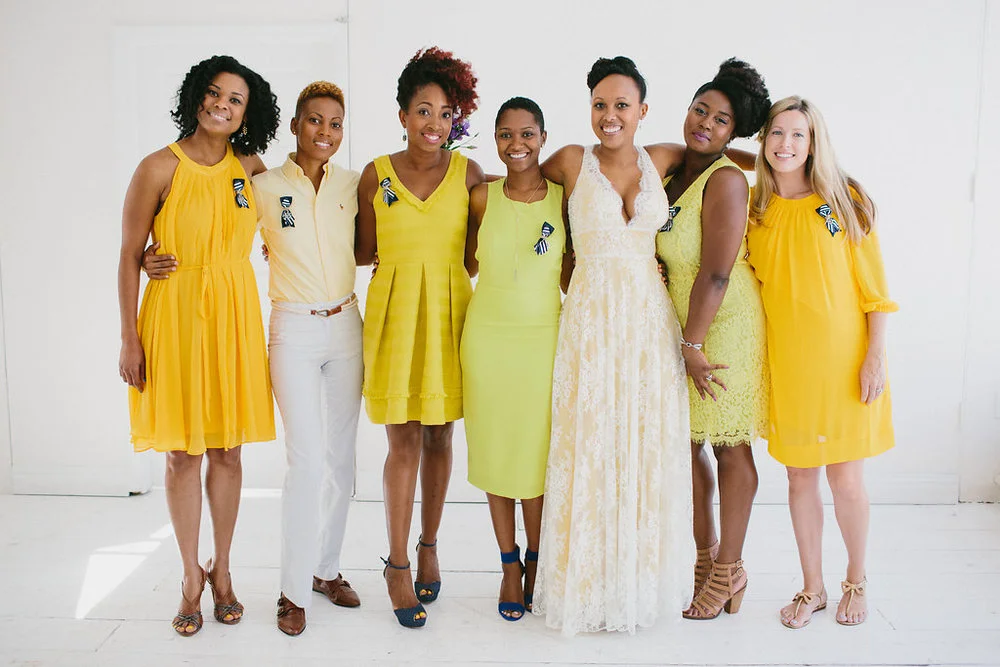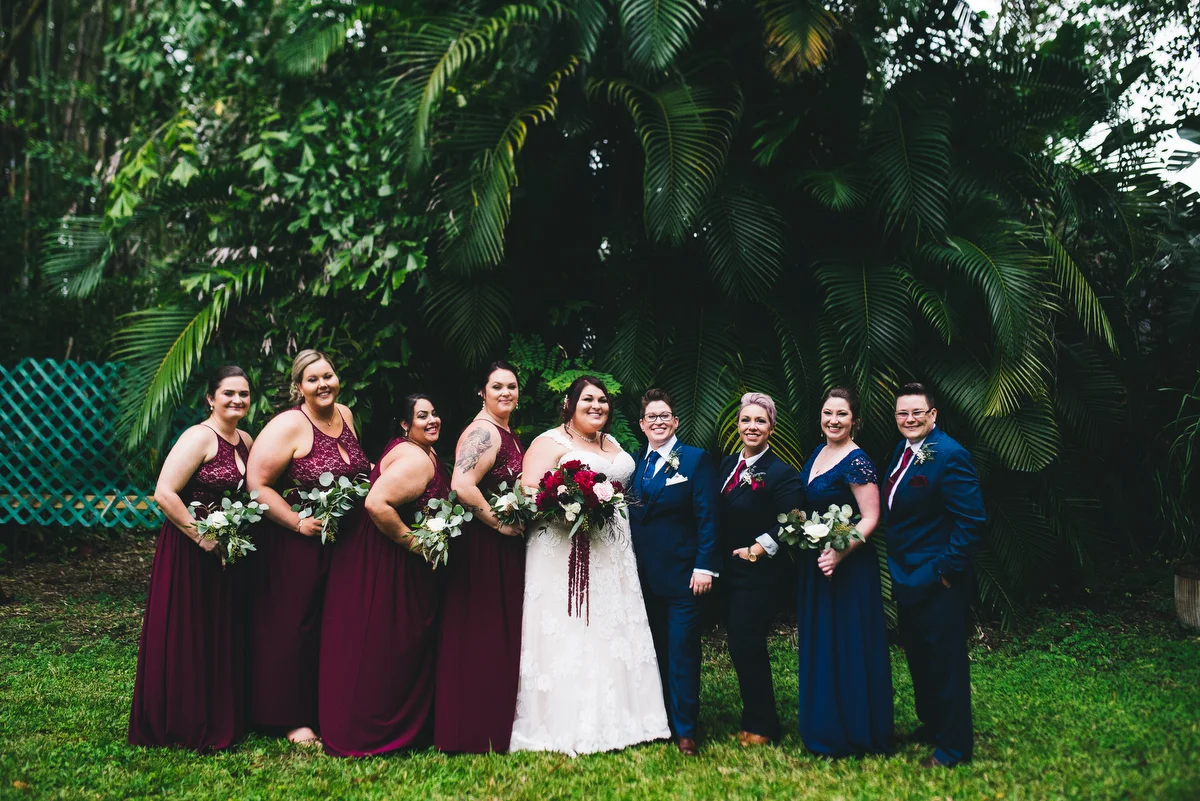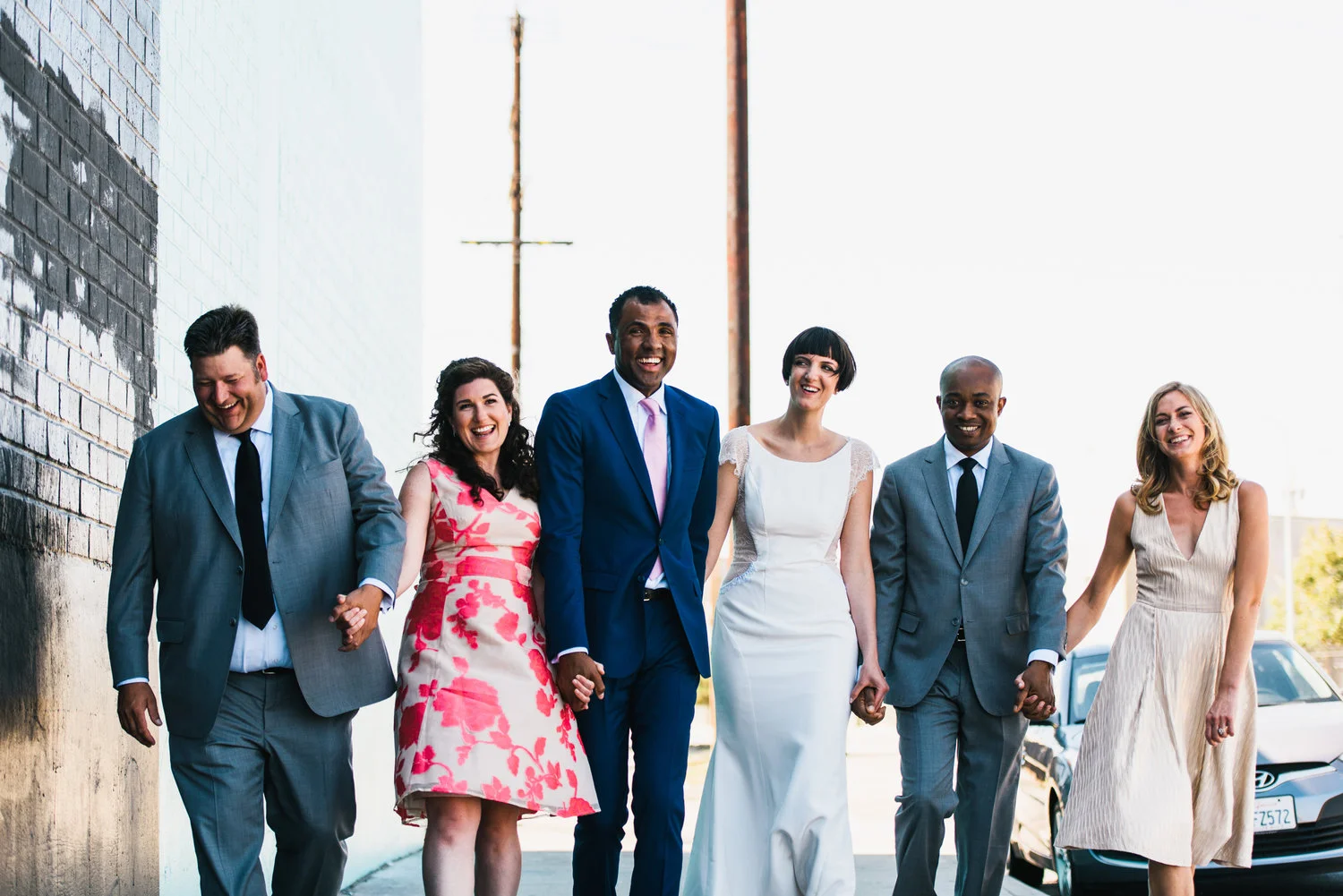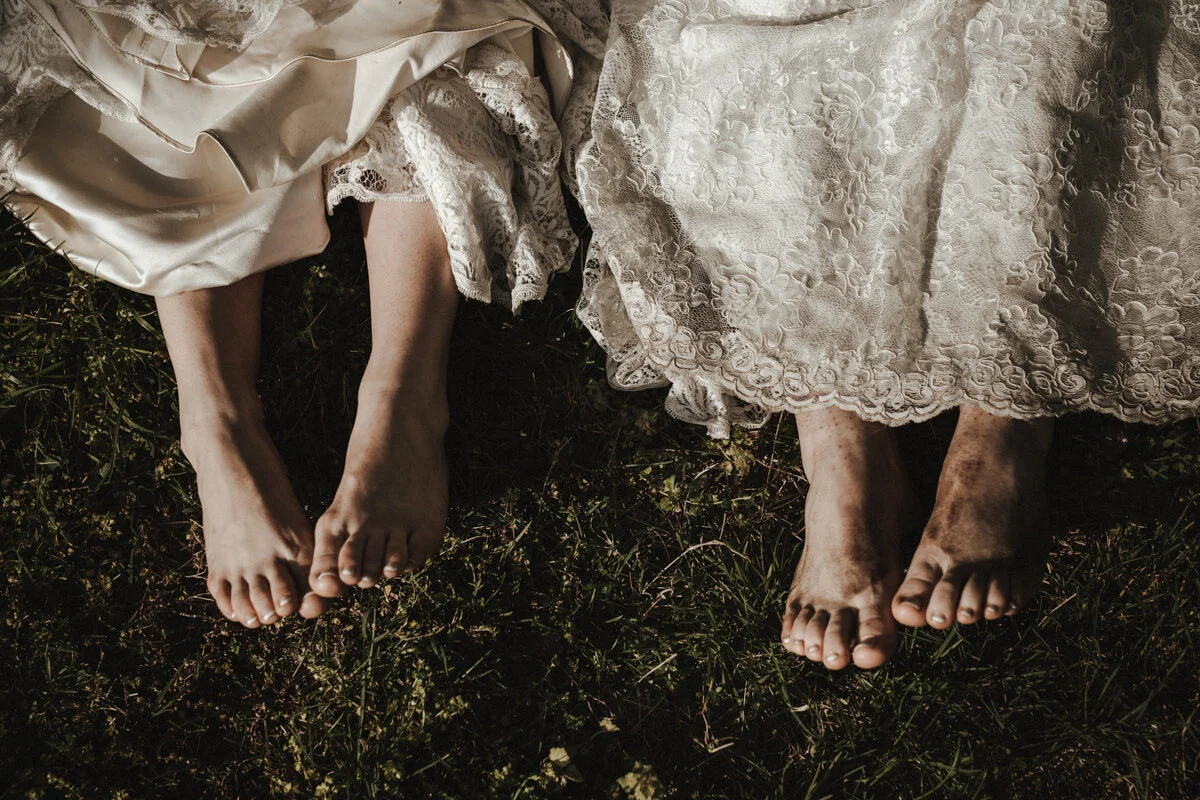Should You Really Tell Your Wedding Party What to Wear?
/Photo by Jessamyn Harris
Catalyst Wedding Co. may receive compensation or products from companies mentioned in this article. This helps support our site.
We all have a picture in our heads when we think about weddings and wedding parties. There’s a bride and a groom standing in the center and they are flanked by bridesmaids and groomsmen on each side, each dressed in matching gowns and suits. Sure, this might be a pretty picture (if monochromatic and gender normative looks are your thing), but the truth is this idea of how your wedding party should look can be pretty harmful to your friends and family.
We wanted to dig deeper on this, so we posed the question to our vendors: “Should you tell your wedding party what to wear?” The short answer: It’s complicated.
Obviously, we at Catalyst and all of our vendors are approaching this topic already believing that terms like “bride,” “groom,” “bridesmaid,” and “groomsmen” aren’t inclusive enough to cover the variety of gender identities of people getting married. More and more, even if the couple is cisgender and hetero, there’s no need to force their friends and family who they have chosen to stand with them on their wedding day to fall into gendered groups. So out of the gate, we want to stress that we need to drop these terms. Now back to the fashion!
Outfit Guidelines Are Great, But Keep Things Flexible
Listen, we all have someone in our life who would show up to the wedding wearing cargo shorts and sneakers, and if that is not what you had in mind, then it is completely fair to provide your wedding party (and guests) with some guidelines to the formality of their attire, and if you so desire, some color guidelines.
“Guidelines are awesome!,” says wedding planner Cindy Savage of Aisle Less Traveled. “Most folks actually really want your input because, like you, they have been trained that this day needs to be perfect and they want it to be the best for you. And they want you to be happy because they love you!” Giving no guidelines whatsoever can definitely be hard on your wedding party, as no one wants to end up as the one who is either very over- or under-dressed. That can lead to members of your wedding party feeling awkward or embarrassed, and that’s definitely not what you want for your loved ones on your wedding day. Do your best to keep your guidelines limited to color, aesthetic (for example, beachy prints for a destination wedding), and level of formality so that you are not creating an exclusionary space for your loved ones.
“Folks should be aware and considerate when it comes to gender expression,” says photographer Carly Romeo of Carly Romeo & Co. “Obviously, it's not cool to tell someone who usually doesn't wear dresses or who doesn’t dress femme that they need to wear a dress.” This goes for all of the members of your wedding party. Be sure that your guidelines provide enough flexibility that everyone can wear something that they feel expresses their individual gender identity. Thankfully, there are lots of options for gender non-conforming wedding wear these days.
Additionally, take into account that not all bodies are the same, and not all styles or cuts are going to look great or fit well on all guests. By keeping your guidelines limited to color, general aesthetic, and formality, your wedding party can more easily find pieces that fit their bodies and make them feel great and comfortable.
“I love when folks manage to create a cohesive look for their wedding party while also taking into account their personal style and gender expression,” says florist and wedding stylist and coordinator Erica Greenwold Reisen of Folie à Deux Events. “It's completely possible to do all three things when you stop trying to make everything ‘match’ and instead approach attire as if you were creating a fashion collection or capsule wardrobe. Use colors and design elements that tie the aesthetic together, but otherwise leave your wedding party to select garments and accessories they are comfortable in.”
If you decide you do want some sort of matching element, make sure it fits with everyone’s style, and consider purchasing it on behalf of your guests. For example, if there are some members of the wedding party who will be wearing ties, you may want to have them all wearing ties made with the same fabric to avoid clashing colors or patterns. Purchasing this on behalf of your wedding party is a great gesture, and also means they don’t have to hunt for a tie that comes in just the right color. The Tie Bar offers their ties in a variety of styles, such as standard width, skinny ties, and bowties, so your wedding party can choose the tie that best matches their style.
“In addition to all the positive social implications of allowing some freedoms, the result of giving flexible guidelines is usually this incredibly eclectic collection of similar-but-different wedding party looks, unified in color while still highlighting the diversity of choice, look, and identities that exist in a couple's group of loved ones,” says photographer Meera Mohan-Graham. “I believe that it can enhance and highlight this for a couple and their community in a way that's really celebratory.”
Photo by Corey Torpie
So, What Do Inclusive Outfit Guidelines Look Like?
Wedding planner Cindy Savage shared a few sample guidelines to help get you started:
If you are choosing specific outfits to be purchased, check on size options before deciding and run your neckline styles past your people. Many bridesmaids' dresses or matching suits don't come in larger sizes; strapless/plunging necklines or short skirts may make more modest folks feel uncomfortably exposed.
For the love of all that is good and holy, please don't force people to wear high heels. This will only end with me giving everyone a matching set of blister Band-Aids before the ceremony even starts. Pick a flat option in addition to or instead of a heel. And just a note on flats v. heels generally: You know all the heels are gonna come off when the dancing starts. If your wedding party is wearing floor-length dresses, the hem length that was perfect with everyone's heels is suddenly a couple inches too long, causing tripping, dirty hems, and rips. All of this can be avoided by wearing flats from the start.
As with clothing choices, hair and makeup is highly personal. I strongly encourage you to make any professional hair/makeup completely optional for your wedding party and to let them make their own choices about how to do it. General guidelines, like "Let's all do a nude lip" or "No accessories in your hair, please" are fine, but resist the urge to treat your folks like dress up dolls for your fantasy wedding playtime. You love them exactly the way they are; that's why they are in your wedding party, right? Let them continue to be their fabulous selves on your wedding day.
With each new guideline you add, ask yourself if there is a chance this will alienate any members of your wedding party. If the answer is yes, rethink the guideline.
Photo by Rudy & Marta Photography
Always Ask Your Wedding Party for Input
If you’ve decided to go this route and want to come up with a set of flexible outfit guidelines to provide to your wedding party but you simply have no idea where to start, it’s always a good idea to have an open conversation with your wedding party and ask for their input.
“Asking for input from the wedding party is super helpful in getting them excited about outfits, but also making sure that they are wearing something they feel good in,” says photographer Liv Lyszyk. “It's important to be open to non-traditional wedding party attire and that open mindedness is key.”
Go into these initial conversations with your wedding party with an open mind, and try not to jump to conclusions about what your wedding party might want to wear. Remember, people may be in the process of discovering their gender identity, and they are not required to tell you about every step in that process, or required to divulge their identity. Just because one of your friends has been femme for 20 years doesn’t mean that they still want to wear a dress. Approach all of these conversations with an open mind, and be respectful of all of the input you receive.
Photo by Clarkie Photography
In Addition to Gender Identity and Expression, Consider Everyone’s Budget
We can’t talk about inclusive outfit options without also talking about classism and money. Do your best to create outfit guidelines that take everyone’s personal budgets into account.
“It’s possible that not everyone in your wedding party can afford your first pick,” says photographer and videographer Elizabeth Mealey, “so not giving them a choice can put them in a difficult financial situation. For my own wedding, I made a Pinterest board with color and style inspiration, and let my wedding party pick their own outfits with the inspiration as their guide. They ran their choices by me, but were able to pick what worked for their bodies, gender expressions, and budgets. I was so happy to stand next to them on my wedding day knowing they felt comfortable, beautiful, and fully themselves!”
Again, if you want a specific aesthetic or level of formality that doesn’t align with the budgets of your wedding party, be prepared to help cover the costs or help them to find discount outfits or rentals that will ease the burden on their wallet.
Photo by Chloe Jackman Photography
Remember, Your Friends and Family Are Not Props
“Some people feel, ‘It’s your day, your wedding party needs to look how you want them to.’ That’s shitty,” says photographer Jacqueline Connor, and we agree. Hopefully, you’ve chosen your wedding party because you love them and want to celebrate your relationship with them, not because you want them to be props for your wedding day photos. Remember, even with the most flexible guidelines, your wedding party has the right to choose to refuse the guidelines. Do your best to be understanding and listen to your wedding party if this happens.
“A couple can ask that their guests wear all black, all white, or style their hair in a particular way, however I don’t think it should be a dealbreaker such that they are stopped at the door for wearing a dark color instead of black,” says wedding planner Jonelle McLeod of Bryck and Lace Weddings. “Just as the couple has a choice, the guest also has a choice not to attend if there is a hard and fast rule.” To avoid fallouts and bad feelings on your wedding day, make sure that all members of your wedding party know that they can come to you if they have any concerns about the attire guidelines.
As long as you approach these guidelines with an open mind, you should end up with a wedding party that is incredibly happy and looks amazing!
Jen Siomacco is the CEO and Editor-in-Chief of Catalyst Wedding Co. She works to mesh together her love of feminism, love stories, accessibility, equality, and design into the Catalyst brand. When she’s not traveling the country working to make the wedding industry a more inclusive place, she’s writing on her couch and snuggled up with her husband and SUPER lazy cats.
Photo by Tiffany Josephs Photography

